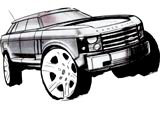Driven to attraction
Hannah Booth talks to Land Rover design director Geoff Upex about nurturing icons and the award-winning, newly-launched third generation Range Rover

Geoff Upex’s passion for the new Range Rover is apparent from the moment we meet. Despite, or possibly due to, having spent the best part of the day at the BBC Top Gear Awards, where the car scooped car of the year and 4×4 of the year, his enthusiasm for it bubbles over.
Upex clearly feels privileged to be working with such a big brand. ‘Land Rover only makes four cars and two, the Defender and the Range Rover, are design icons,’ he says. As the nearest some designers get to icons is a visit to the Design Museum, he can probably count himself a lucky man.
In a market where cars are launched faster than you can say ‘aggressive dealership strategy’, the Range Rover has enjoyed greater staying power than most.
Under the design directorship of Upex, Range Rover’s third model in its 32-year history hit the road last month. It is hoping to win more fans than its predecessor, which lasted a mere seven years. This compares with a 24-year life-span for the 1970 original.
The second generation car suffered from the fact that the original was too popular. ‘It was designed at a time when people valued modernity over character and I don’t think people loved it,’ he says.
A philosophical debate preceded the launch of the third model: whether Range Rover should hark back to the much-loved original or set out in a new direction. It was an easy decision.
‘There is little point in trying to redesign an icon, particularly as Range Rover owners have a strong preconceived idea of what the car should look like. We have tried to retain the character of the original while moving it forward,’ he says.
Recognisable external features have stayed put, such as the upright front and sides and the clamshell bonnet, but the luxurious interiors inspired by ‘classical ocean-going yachts’ have been given a thorough overhaul.
Upex manages a 25-strong design team. He describes his role as steering the designers, providing a wider perspective rather than actually putting pen to drawing board or, in the Range Rover’s case, visiting luxury yachts.
‘I don’t tell the creatives what to do, it would be a waste of creative brain power. I just nudge them in the right direction,’ he says.
He is anxious not to repeat the mistakes of the second model, which was ‘over-designed by someone standing too close’.
No outside consultancies worked on the Range Rover, but, surprisingly, the in-house team actually had to pitch for the work against two BMW design teams.
When pressed, Upex is coy. ‘[BMW] was simply asked to put in a proposal as well, but it wasn’t picked. Competition keeps you on your toes,’ he says.
‘It will take a car designer around 18 months to mentally stop designing a car and get into the mindset of a new one, which is why I prefer product designers to car designers every time,’ Upex explains.
Indeed, he learned his trade studying industrial product design at the Royal College of Art, sharing a flat with contemporaries Richard Seymour and Dick Powell.
‘It was great as we hardly did any work. But the [three-year] course had no structure except for the final-year presentation,’ he says. Unforthcoming again, Upex refuses to disclose the subject of his final show. ‘You wouldn’t want to know,’ he smiles.
He clearly doesn’t want to dwell on the past, or himself, and is happier to return to the subject of the Range Rover. It was tested in diverse conditions, from the wilds of Alaska to traffic jams in Tokyo and Scottish rivers a metre deep.
‘People who buy and drive Range Rovers are not trained, unlike an airline pilot, so you have to make sure the car can handle extreme situations,’ according to Upex.
But it could be said the nearest most Range Rovers get to rivers are puddles in a Waitrose car park, leaving its functions superfluous. ‘Do you need to do 175mph in a Ferrari? Not everyone uses all the functions [of a car],’ he replies.
The extensive market research dictated changes along the way, but design details aren’t road-tested with consumers. ‘We would never ask people whether they like a particular headlight or dashboard finish. If we did, we wouldn’t need a design department,’ says Upex.
Large gas guzzlers are not particularly Green, but Upex says the Range Rover is eternally popular and owners are not swayed by environmental concerns. ‘[Buyers] simply want to own a Range Rover because it’s a Range Rover. The cost of running it is not an issue to them.’ He says, if anything, the brand is underexploited, particularly in the US where it is not achieving its sales potential.
‘Over here, Range Rovers transcend even class boundaries, with a broad range of owners from footballers to Peers of the Realm.’
The Range Rover redesign may be behind him, but Upex is not short of things to do. The design team will be redesigning the remaining three Land Rover brands, starting with the Discovery, followed by the Freelander and Defender.
And you never know, he could make it four icons out of four.
Geoff Upex’s CV
Born: Redruth, Cornwall
Education: Truro School; Coventry University – BA industrial design (transport); Royal College of Art – MA postgraduate industrial design
Career: 1977-1983 Ogle Design; 1983-1999 Rover Group: 1983-86 chief designer – car interiors, 1986-1989 chief designer – medium cars, 1989-1995 chief designer – Rover cars, 1995-1999 design and concept director; 1999-2000 design director – BMW Group UK; July 2000-present Land Rover design director – New Range Rover
-
Post a comment



